Marian Allen's Blog, page 387
September 19, 2013
Cherry Tomato Relish – a #Food, Not a Stripper
Friend and reader Jane Peyton, author of the wild fun-ride, Callie London’s Vampire Adventures (When Push Comes to Shove), asked for this recipe, and I am nothing if not responsive to requests from friends and/or readers.
I’m particularly happy to have this recipe for three reasons: It’s a favorite of my husband’s. It’s his mother’s recipe. My copy is in her handwriting. She’s been gone for some years, but there’s nothing quite like food made from a private recipe written in the dear one’s hand to keep her memory green.
So, then, here is Mrs. Allen’s recipe for using up green tomatoes that you don’t want to fry, or are too small to fry.
SOUR RELISH
1/2 gallon green tomatoes
1/2 gallon cabbage
1 hot pepper
1/2 cup salt
4 cups of cider vinegar
2 cups of water
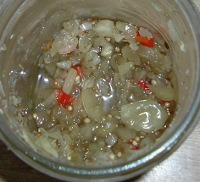 Chop vegetables coarsely and mix well.
Chop vegetables coarsely and mix well.
Work the salt in. Let stand overnight or put in jars right away. Pack down tight. Leave lids loose.
Rinse and drain.
Combine remaining ingredients (add spices and a bit of sugar, if desired, according to Charlie’s sister Marilyn). Heat to boil. Simmer for 3 minutes. Pour over vegetables and seal.
~*~
Me, I would store the jars in the refrigerator if I didn’t put them through a canning bath.
A WRITING PROMPT FOR YOU: A character finds an old recipe in a handwriting they recognize and cooks it.
MA

September 18, 2013
Homebodies
Charlie and I are homebodies. I always preferred to stay home, even when I was a kid. There was no adventure I was offered that didn’t sound like a little slice of hell, if it involved going somewhere.
In my teen and young adult years, I enjoyed going and doing, seeing different places and meeting new people. I still like those things; I just don’t like having to leave home to do it. The day somebody invents cheap (free) virtual reality tourism, where your hologram goes to a real place in real time and interacts with real people, then you take off the headset and you’re home will be a happy day for me.
Charlie was away this past weekend, barely out of the state, with friends. It was hard on both of us. I spend the weekend away several times a year, at conventions and book fairs, but that happens so often we’re sort of used to it. He doesn’t do many overnights unless I’m with him.
I cheered myself up by eating things he doesn’t care for: eggplant, storebought chicken, super-gloppy-chocolatey sweets. By the time he got home, I was relieved to be back to our usual fare.
And of course I’m happy to have my best friend home again.
But I do miss the chocolate.
A WRITING PROMPT FOR YOU: If you could go anywhere virtually, where would you go? Would you rather have a new adventure, or relive one you had had before? Would you rather have a “canned,” scripted “adventure” or a real one, with the only danger being that nothing interesting would happen?
MA

September 17, 2013
#Food for #Vegans Again
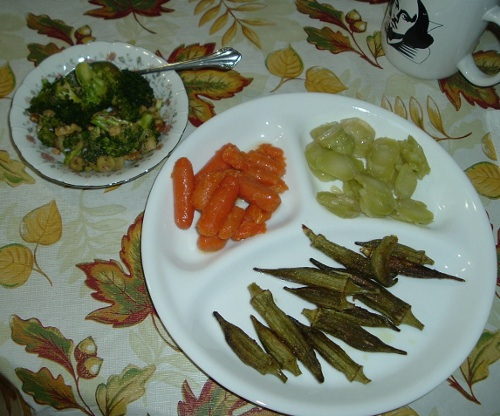 Now, then, lemme tell you about this good stuff!
Now, then, lemme tell you about this good stuff!
Up there in its own li’l bowl is broccoli salad. That’s broccoli florets, walnuts, green onions, and a half-and-half mix of mayonnaise and pesto. Use vegan nayonnaise and pesto made with cashews instead of cheese, and this is vegan.
When you use the florets, you have the stems left over. Don’t waste ‘em. Call ‘em rabe (rahb) instead, and eat ‘em. I peeled the tough outer layer off and sliced them a little on the diagonal to make ovals. I sautéed onions and fresh minced garlic in vegan margarine, added the rabe, added a cup of veg boullion, and simmered it until the rabe was tender. I saved the broth, of course, for soup.
I was in a hurry with the carrots, so I used canned, although freshly cooked would be nicer. I heated fresh chopped rosemary and orange zest in vegan margarine, then poured it over the hot carrots.
Don’t turn up your nose at okra unless you’ve tried it like this: Toss with olive oil and seasoned salt, and roast at 450F for about an hour, turning once. Don’t worry if they cook a little black in spots.
And, yes, that IS my imaginary dead playwright boyfriend on my coffee cup.
I’m posting today at Fatal Foodies about the mirza ghassemi I made this week.
A WRITING PROMPT FOR YOU: What if Shakespeare wrote a cookbook?
MA

September 16, 2013
Life Into Art
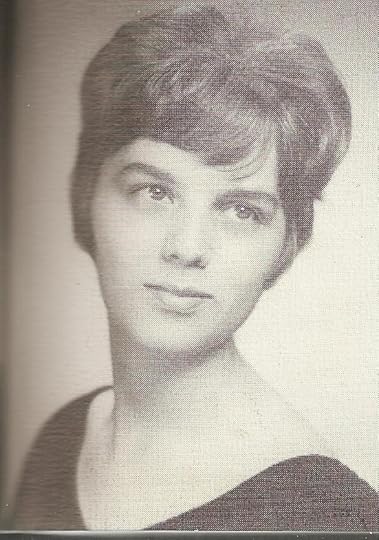
Portrait of the writer as a young chick.
According to Seymour Rothman, newspaperman and author of YOUR MEMOIRS, COLLECTING THEM FOR FUN AND POSTERITY, “Memoirs are about you and life.” So is any form of writing, if you care about it. Many authors, especially in the past, kept diaries or detailed journals; recording events, the authors’ impressions, and any ideas for characters or plots sparked by those events.
But let’s take memoirs as a starting point, go through writing one’s life, and end with writing from life.
Memoirs are like autobiographies, but less formal. Autobiographies are expected to be very precise and verifiable. Memoirs are your memories: What you remember happening, what you remember thinking or now think about what happened, and what you learned from the event.
Rothman suggests beginning with five envelopes, labeled: Dates, History, Thoughts, Lessons, Miscellany.
DATES: Make lists of all the dates you remember. If a date sparks a memory, or a host of memories, write those memories down on separate pieces of paper and put them in the appropriate envelopes. If they would go just as well in one envelope as another, put them wherever you like; it’ll all come together in the end, anyway. Mr. Rothman suggests heading your date lists: Forebears, Birthdays, Residences, Education, Employment, and Good Times and Bad. I would add Deaths, Important personal events, and Important public events. The dates may be exact, or approximate, or you may remember events but not the dates. You can dig for the dates later; for now, just name the event. You may not have any usable memories connected with a date, but thinking about that date might free-associate into usable memories: (You may not remember anything special about any of your baby brother’s birthdays, but you may have many special memories about your baby brother.)
HISTORY: As far as family history goes, if you don’t have facts, put down clues. Clues were what led Alex Haley to the re-creation of his family’s history. Collect stories from relatives and friends and your own memory: Birthing stories, holiday stories, funeral stories, illness stories, accident stories, car stories, pet stories.
THOUGHTS: Your thoughts express your philosophy of life, your personality.
LESSONS: Ask yourself: What is the most important lesson you’ve learned in life? Why do you say that?
Thoughts and lessons are very close, sometimes intertwined. Don’t worry about that; again, it doesn’t matter what envelope you put it in, as long as you get it out of your head and into an envelope.
SOURCES: for locating, remembering, or dating events: The old family Bible, letters, scrapbooks, school yearbooks, diaries and journals, old city directories, genealogies, photos, newspaper clippings, business papers, report cards, documents, souvenirs and programs, school essays themes and dissertations, old “TV Guide”‘s, old magazines, old movies, favorite foods — a major source, ultimately the major source, is YOUR MEMORY.
Violet Windell told me that she began her autobiography in 1947 or 8, about three years after she had a nervous breakdown, in an attempt to answer the questions, “Why does my life work out this way? How did it all begin?” She wrote down her memories as they occurred, and later sorted them by time and related content. She says she came up with these memories alone, as she had always felt alone; it didn’t occur to her that anyone cared enough about her past to want to discuss it with her. Let it occur to you. Rothman says, “Talking about yourself opens your memory. Exchanging memories and experiences with others reminds you of things long forgotten.” This is true whether you’re talking to someone who’s known you all your life, or a stranger in the doctor’s waiting room.
When a conversation, or something you’re reading — anything — sparks a memory, hold onto it and make a note of it. You can expand it later.
PUTTING IT ALL TOGETHER: Collect your dates, actual or approximate, and match the events with them. This gives you an outline in chronological order. Match events to dates, lessons and thoughts to events. If you have lessons and thoughts left over, save them for something else, or put them at the end of your book under the heading of Random Ramblings, or Advice to the Young or something.
If you want to center your autobiography on one pivotal event or set of events, you may want to select only those events, thoughts, and lessons which had the most bearing on what you see as the heart of your story.
Begin by picking an imaginary reader for whom you are writing. What kind of image of yourself do you want to project? What message do you want the work to carry? What is this piece of writing for? Who is it for?
1) Start out with a Preface answering these questions: Who am I? Why am I writing this? When am I writing this? What is my current situation?
After this, you may structure your book however you like: ordered by date, ordered by subject, completely random, or centered on one Big Event.
For instance, let’s take Edith. She has had a major experience that she wants tell about, maybe for herself, maybe for her family, maybe for other people who are going through the same kind of experience. She might follow her preface with:
2) Family history
3) Memories leading to (what Rothman calls) the Big Event
4) The Big Event
5) Anti-climax and wrap-up.
Part 4 will, of course, be longer and more detailed than the others, and the length and detail of the others will depend on the length of the work as a whole. The finished book may be typed on bond paper, or handwritten and the pages put in a magnetic notebook, or printed and bound, or available electronically, or recorded for audio. It’s your story.
A WRITING PROMPT FOR YOU: Start some of those envelopes. If nothing else, it might be fun!
MA

September 15, 2013
#SampleSunday The Horror I #amwriting
I’ve been working on the story, and I think I’m maybe two-thirds through the first draft. Sometimes I can blast through a rough draft, but usually I have to write slowly and carefully, sort of creeping up on it like some kind of creepy creeper.
Anyway, here’s the very first bit:
The One That Got Away – excerpt
by Marian Allen
It was summer when Tom drowned. He was four and thought he was one of the big boys. His cousin Tanner was ten, and just barely qualified. The big boys all went down to the creek that day, and Tommy ran after them when his Mom took her eye off him for a second.
The older boys had gone past the creek to tease Coby’s bull through the fence, but Tanner had stopped to hunt for crawdads in the shallows near the dam. Tommy sneaked up on him, planning a big BOO, but Tanner wasn’t alone, after all.
Another boy, dressed in baggy clothes and a brimless cap, stood motionless, watching Tanner. His eyes didn’t move, but Tommy had the feeling he was watching both of them.
Tanner, just because he was older, was Tommy’s hero, and this boy being with him sent a spike of jealousy through the toddler. He kicked some gravel into the water to scare off anything Tanner might have been stalking. Tanner turned on him, but Tommy glared back.
“Whozzat ully boy?” Ully being the way Tommy said “ugly” at that age.
And the boy was ugly: His forehead and chin slanted back and his cheeks and mouth jutted forward, as if someone had broken a small bowl in half, turned one half upside down over the other, and strapped them to his face beneath his nose.
“What boy? You’re the only ‘ully’ boy I see around here.” Tanner shoved Tommy, who flopped onto his behind and kept going until his head bounced off the creek bank.
Before Tanner’s anger had time to shift to fear, the ugly boy came between them. He grabbed each of them with one hand and pulled them into the water. He sank like a stone and slid, on his back, out of the shallows into the pool below the dam.
Tommy held his breath as he slipped through the water, down past flickering minnows to the muddy creek bottom. He tried to pull free, but the boy’s grip was unbreakable. Through the murk, Tanner mirrored Tommy’s struggles on the strange boy’s other side, teeth bared, feet and free arm flailing. Tanner brought his feet together and braced them against the boy, pushing with his legs, pulling with his arms.
The stranger snuggled closer to Tommy. No – the arm on Tommy’s side got shorter, pulling him closer, as if the boy’s arms were not connected to his body, but were one long tube that ran through a hole in his shoulders.
The next thing Tommy knew, he was clinging to the creek bank downstream from the pool, vomiting up foul water and mewling like a kitten, bone-cold and dizzy. Then he was in a tall bed with his mother and Tanner’s mother standing over him, crying.
They told him that he had fallen into the pool below the dam and Tanner had drowned trying to save him. Since that made more sense than what he remembered, he supposed they were right.
~ * ~
A WRITING PROMPT FOR YOU: Take a childhood memory and make it weird.
MA

September 14, 2013
#Caturday Expect the Inevitable
Katya Graymalkin here.
Charlie left some rags on the hearth and guess what? Yes, I schooled him. I think he’s learning, because he washed out the pee, he only cussed a little bit, and he skritched me under the chin a couple of days later.
Mom ordered two refurbished laptops for herself and Grandma. She’s too cheap to buy them new. I suppose she’ll be looking to me to help her configure them and keep them running. The curse of being a tech-savvy cat! I’ll have her take a picture when hers gets here.

Did you plug it in? Did you turn it on?
She’s gearing up for NaNoWriMo (National Novel Writing Month). I think she should write one with cats in it, don’t you?
A WRITING PROMPT FOR CATS: Take a story without cats and rewrite it with cats in. Better, isn’t it?
MA

September 13, 2013
The Best Seven Miles Ever
I’m referring to my new favorite blog, Seven Miles of Steel Thistles, the blog of Katherine Langrish. In fact, today is all about Katherine and all her works and all her ways. Katherine, you see, is all about fairy tales, folklore, and fantasy. Also, subjects that do not begin with the letter “f”.
Her latest work is the short story Forsaken, a different take on Matthew Arnold’s poem “The Forsaken Merman”. Longtime readers of this blog (Hi, Mom!) know that my first published book, Eel’s Reverence, was inspired by that same poem. 
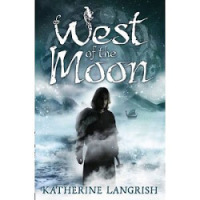 Be sure to check out her Fairytale Reflections tab, with its links to many major fantasy writers’ essays on various fairy tales. It’s going to keep me occupied for quite a while.
Be sure to check out her Fairytale Reflections tab, with its links to many major fantasy writers’ essays on various fairy tales. It’s going to keep me occupied for quite a while.
I also just bought one of her fantasy novels, West of the Moon. I’m sure I won’t be disappointed!
A WRITING PROMPT FOR YOU: Pick a Victorian poem and outline a story based on it from a different perspective than the poet’s.
MA

September 12, 2013
Mary and Henry
This is what courage looks like.
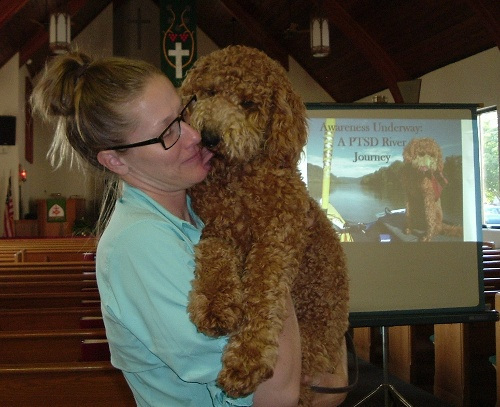 Mary Southerland is one of the bravest people I’ve ever met. She was one of the thousands of civilians employed by military contractors working in Iraq and Afghanistan. She returned home suffering from Post Traumatic Stress Disorder.
Mary Southerland is one of the bravest people I’ve ever met. She was one of the thousands of civilians employed by military contractors working in Iraq and Afghanistan. She returned home suffering from Post Traumatic Stress Disorder.
In her own words:
Before the incidents that caused my disorder occurred, I doubted the diagnosis. I believed it was an ‘invented excuse’ or ‘weakness’- I am embarrassed of this prior opinion.
After over 7 months of fighting for benefits, I can no longer permit the disorder and the struggle for help allow me to be ashamed, humiliated and trapped. To get well (or a new ‘well’), I am going stand up for myself and others enduring this process and break the stigma of a psychiatric injury.
Although Mary and her fellow contractors have been stalled on or refused benefits by their employers (the contractors), her admiration for the servicemen and servicewomen next to whom she worked inspires her to put them first.
Before the needs of contractors are addressed, we need to take care of our military members.
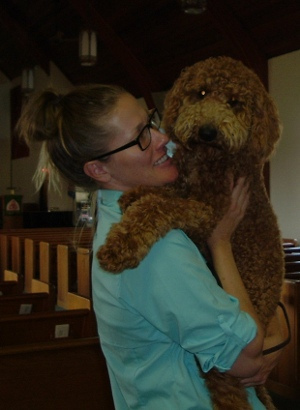
Love.
Mary — with the help of her service dog, Henry, and her support team — is kayaking down the Ohio river, stopping and speaking wherever she’s invited. Her determination is to raise awareness of the PTSD suffered by our military and the contractors the United States government hires to supplement or substitute for enlisted troops. She carries with her a petition from the Purple Star Families, urging better mental health care for service members and better and more quickly accessible mental health benefits for veterans.
Although her PTSD makes it difficult for Mary to be in crowds, especially to speak before them, she faces that stress at every opportunity she’s given in order to advocate for her former comrades, her fellow contractor employees, and herself.
Please visit her website, A Contractor And Her Dog, to read more about her, about PTSD, and, of course, about Henry. Sign the Purple Star Families petition. Read this Pro Publica report on what it calls the Disposable Army. Contact your elected officials.
A WRITING PROMPT FOR YOU: Do something.
MA

September 11, 2013
The Ladies
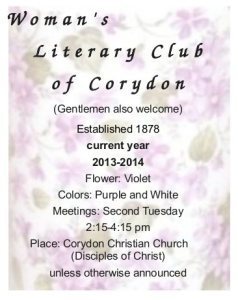 Mom and I belong to the Woman’s Literary Club of Corydon, established in 1878 — no, we are not original members. I joined not long after we moved here, and Mom joined not long after she moved here. The women who were long-time members when I joined are gone, now, and new members have been added. I promised Mildred, the woman who recruited me, and who was a daughter of one of the founding members, that the club would never die as long as I was alive. She would be happy to see how many members we have: it fluctuates around the original limit of 15.
Mom and I belong to the Woman’s Literary Club of Corydon, established in 1878 — no, we are not original members. I joined not long after we moved here, and Mom joined not long after she moved here. The women who were long-time members when I joined are gone, now, and new members have been added. I promised Mildred, the woman who recruited me, and who was a daughter of one of the founding members, that the club would never die as long as I was alive. She would be happy to see how many members we have: it fluctuates around the original limit of 15.
She would also be happy to see that it has continued to be a group of women who are very different from one another but get along beautifully. There has never been any cliquishness. There has never been anything but enthusiastic welcome for new members.
We used to all read the same book at the same time, but that was no fun. We didn’t like having an assigned book, and having to read something we didn’t like. So we decided to choose a theme for the year and have each member be responsible for presenting a book to the group. That way, we get introduced to books we might never have chosen or might have resented having to read, and we can borrow the books from the presenters if they sound interesting.
This year, the theme is mysteries.
Last month, I reported on the Judge Dee mysteries. This month, the presenter reported on Jason Goodwin’s mysteries set in the declining Ottoman Empire. Since she’s studied Middle Eastern Dance, she did some Middle Eastern Dancing for us.
I love my club!
I can’t wait to see what the program is, from month to month.
A WRITING PROMPT FOR YOU: Make some alphabet cards. Shuffle them. Pick one at random, write it down, put it back. Pick another one, write it down, put it back. Go to the library and go to the fiction section. Choose a book at random from an author with those letters at the beginning of his/her name. Read the book. Wasn’t that fun?
MA

September 10, 2013
Deer, Deer, Deer
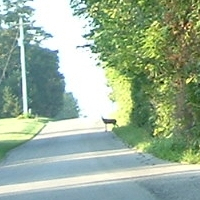 I was driving along, minding my own business, when I looked up and saw this.
I was driving along, minding my own business, when I looked up and saw this.
In case you can’t tell what it is, it’s a deer. Probably a doe, though it could be a young buck. I didn’t see any horns or antlers or whatever it is that boy deer have on their heads, and I didn’t see any Bambi spots, so I kinda sorta think it’s a doe.
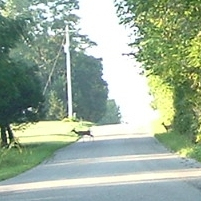 I stopped the car, of course, because I’d rather look at a deer than be on time. She looked back at me, decided my camera wasn’t some kind of camouflaged boom-stick, and this happened.
I stopped the car, of course, because I’d rather look at a deer than be on time. She looked back at me, decided my camera wasn’t some kind of camouflaged boom-stick, and this happened.
I do have a video thing on my camera that takes about 13 seconds of video, which would have been plenty of time for this, but I use it so seldom I didn’t even think about it.
Here are some fun factoids about venison, which we do not eat.
Food historian Waverly Root writes that “venison” refers to any mammalian game animal, but most of us think of deer when we hear the word, so that’s what it means here.
Deer as we know them were around before we were, and people have been hunting and eating deer ever since we showed up. Deer was hunted and eaten in China, Borneo, France, Persia, Germany, Switzerland (I mean, of course, the lands where these countries would later be defined)–all over the world.
During the European Middle Ages, the king reserved all game animals for himself and his lords (and poaching flourished).
Many manuscripts were devoted to The Hunt–instructions, descriptions, fictions and allegories.
Women were not barred from The Hunt, though it was more common for them to be part of the social aspect of the occasion.
Although deer are prolific, there is a very small commercial market for venison. In the USA, hunters are forbidden to sell their kills, but many of them donate venison to food banks. Charlie saw some nibbling at his blueberries this spring–deer, not hunters–and I thought WE were going to be making a donation.
We really have to watch out for deer on the road, which I’m happy to do, unless there’s a speed demon riding my tail, hustling me to drive faster, dammit. When that happens, I grit my teeth and keep my speed down, hoping I don’t get caught between a buck and a truck. So far, so good.
I’m posting today at Fatal Foodies about two-ingredient recipes.
A WRITING PROMPT FOR YOU: A character is caught between something pressing them from behind and blocking them from before.
MA
p.s. Sekrit messidge to Jane: It’s September 10. Do you know where YOUR werewolf is today?





